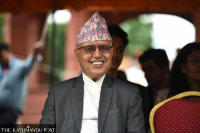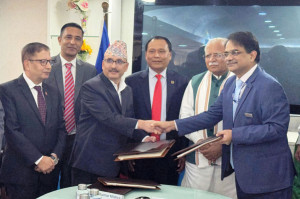Money
‘World Bank can help build Kathmandu-Tarai fast track’
Since the end of the armed insurgency in 2006, Nepal has been struggling to achieve higher economic growth rates.
Since the end of the armed insurgency in 2006, Nepal has been struggling to achieve higher economic growth rates. In fact, Nepal had started gearing up for higher trajectory of economic growth beginning fiscal year 2013-14, when gross domestic product (GDP) growth stood at 5.7 percent. But the devastating earthquake of April 25 and subsequent aftershocks shaved an estimated Rs 36.52 billion off the projected GDP of fiscal year 2014-15, limiting economic growth to 2.32 percent. As Nepal was rising from the rubble of the quakes, India imposed a trade blockade from September 2015 to February 2016, chocking supplies of petroleum products, raw materials and other essentials. This reduced the country’s growth to 14-year low of 0.8 percent in 2015-16. Rupak D Sharma of The Kathmandu Post caught up with Annette Dixon, the World Bank vice president for South Asia, to discuss Nepal’s economic prospects and support the multilateral lending institution can extend to spur growth. Excerpts:
Nepal survived a very big earthquake and a trade blockade imposed by India, which constrained the country’s economic growth to 0.8 percent. What is the World Bank’s outlook on Nepal’s economy?
I think earthquakes and disruption along Nepal-India border points were two unfortunate events that Nepal faced. After a natural disaster, reconstruction works generally help the economy to recover. Although reconstruction works were initially delayed, they have now started to pick up. Of late, housing reconstruction grants have started reaching households and this will help in economic recovery. So, we expect the growth rate to rebound to 5 percent in fiscal year 2016-17. In the longer term, Nepal’s economic growth prospects look positive, but I think the drivers of growth probably need to change from consumption-driven by remittances-to investment, as it would help create more jobs. Investment-led growth also helps in social inclusion and it will help the growth to be more sustainable in the long run.
For investment-led growth good transport and energy networks are critical. The World Bank has been supporting the country to improve these infrastructure. But things are not moving ahead in a desired manner, isn’t it?
Nepal needs to accelerate the pace of development of transport and energy networks to bolster confidence of investors. If investors know that project development is moving ahead at a desired pace, they will encourage other investors to come into the country. So, it is very important to complete projects on time. I know Nepal faced some challenges in attracting investment. This was largely because of delays in procurement process and low speed at which bottlenecks were removed. I know development projects have to deal with a lot of complicated issues and this is true everywhere. They involve complicated policy issues or issues around social or environmental impacts and land acquisition as well. These are difficult things to handle for any country. But the speed with which the government and the private sector work to resolve these issues is important. The World Bank and other development partners are helping to get some of these projects moving. If couple of these projects move forward soon, more confidence will be built.
Don’t you think there are problems on World Bank’s part as well? For instance, the Bank’s social and environmental safeguard standards are quite stringent and very difficult to meet at times. What is your take on this issue?
I think those standards are really important to protect the local people and the environment. But we’ve just updated and modernised the social and environmental standards and they will be implemented next year.
But even so I think it is worth taking time to get these things right. If you engage in any project that involves resettling people, it’s really important that those people are moved to areas that are better than where they were living, and as close as possible to their former homes. So, this process has to be followed really carefully, because the benefits of the development actually have to be shared with everybody, including people who live in the vicinity of the project sites.
But what if newly-established multilateral lenders like China-led Asian Infrastructure Investment Bank and BRICS Bank jump into this space and push institutions like the World Bank out of the scene?
Actually, all the multilateral institutions follow the same standard. And the new banks are adopting the same standards. But actually these standards are not about the World Bank. It is about the country where the projects are built. Projects that don’t harm the environment or the local people, share benefits transparently and manage revenue efficiently actually help build confidence and social cohesion. And I think building social cohesion is really important in Nepal, which has a history of conflict.
Recently, your country director talked about increasing concessional funding over the next three years starting 2017. Would you like to comment on this issue?
We’re going through the process of replenishing the concessional funding window-the International Development Association (IDA), which is the fund for the poorest countries. So, Nepal will get more funds from next year. In fact, all the countries that are receiving IDA’s support will get more funding from next year, but countries that are very fragile or have emerged from conflict, like Nepal, will get very large increases. Right now, the country is going through the process of decentralisation or federalisation and it is really important that we intervene to help improve service delivery system and build social cohesion.
But as you know the government’s fund absorptive capacity is very weak and it may not be able to utilise additional funds extended by the World Bank. What is your take on this issue?
Well, I think it can be sped up and a good example right now is the pace at which grants are being distributed to earthquake victims who need to rebuild their houses. The grants are actually being distributed by the government directly to the households by depositing money in bank accounts. The households then are sourcing materials from the local market. All this is actually happening very fast. I think the other thing that the World Bank is doing is financing projects based on results. So, countries these days receive funds once they have achieved results. This is actually speeding up implementation.
You appear pretty satisfied with the post-earthquake housing grant distribution process. But even after 19 months of devastating earthquakes, many households haven’t received the first instalment of the grant. What does the World Bank, which is supporting housing reconstruction, have to say about this?
I went to Nuwakot district couple of days ago and talked to beneficiaries. I also saw the administrative system there and training being provided to households to enable them to build quake-resilient houses. So, the progress made by Nepal at this stage is quite similar to achievements made by countries like Pakistan and Indonesia that experienced big earthquakes. I know it was a slow start but the process has lately gained momentum. I think over 430,000 households have received the first housing grant instalment. And you can see lots of houses being built following the new housing standard.
The government recently decided to raise the housing grant by Rs100,000 to Rs300,000. Is the World Bank interested in providing additional support as well?
We’re currently discussing this issue. It is important that we make sure the additional grant assistance goes to households that need this support the most, particularly those in remote areas, as they do not have easy access to marketplaces to purchase building materials. Also, the scheme should be affordable to the government. We are committed to working with the government and want to make sure the scheme is a success.
So, the World Bank will provide extra support if the country meets the conditions?
We haven’t put any conditions down, but we always work with the government to help it achieve its objectives. And the government’s objective is to help people rebuild their houses.
So, how much fund would the World Bank provide?
At the moment the government hasn’t asked us. So, we actually haven’t had this discussion. But we are certainly going to continue supporting the scheme. And we are very open to holding discussions on further financing, once the existing funds, which have not been fully utilised, are absorbed.
So, along with the reconstruction drive what areas should Nepal focus on to spur growth?
Nepal should strive for inclusive growth. I think Nepal should also continue upgrading skills of people and focus on providing quality education. Focus should also be laid on building new infrastructure and improving the existing ones, particularly in energy and transport sectors. Also, the investment climate should be made favourable. All of these things are critical for creating more jobs here. I think agriculture will continue to play a critical role in the economy. For this logistics and transport services are also important because they can add more value to products generated here. The other big opportunity is in the energy sector. At the moment, Nepal doesn’t have adequate power supply, but over the time Nepal has the opportunity to become an energy exporter. Energy export will provide additional revenue to the government which can be used for country’s development. These are actually the visions of the government and we are keen to play a supportive role.
Talking about the energy sector, Nepal was forced to spend over 20 years in darkness after the World Bank abandoned the Arun III project. Any comment?
Well, I know about this incident but I don’t know much because it occurred before I joined the World Bank. But I think we went through a process where we changed our policy. However, we have once again started to reengage in hydo projects. The first hydro project that we helped build after that period was Nam Theun-2 in Laos and since then we have supported development of many hydro projects. In Nepal, we are supporting Kabeli A and Upper Trishuli hydro projects. So, we no longer hesitate to support hydro projects and are keen to assist in development of hydro projects here as well.
There are also rumours that WB is interested in building Kathmandu-Tarai fast track. Is this true?
We’ll look at it very closely if the government requests us to build it. We think these types of projects would significantly reduce logistics and transport costs and help the economy grow faster. This is a country that has fairly low coverage of road transport network and this is a project that can provide huge benefits to the country. So, if the government requests us to build the project, then we’d be willing to look at it very closely.




 23.12°C Kathmandu
23.12°C Kathmandu














